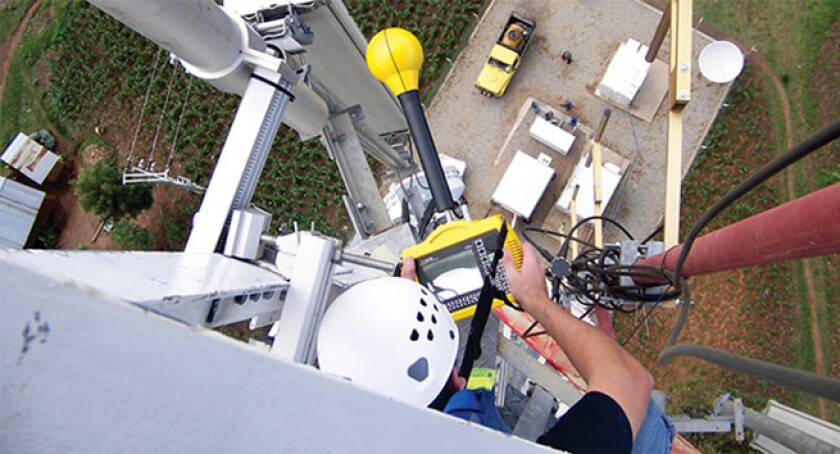TowerXchange asked three influential practitioners at leading multi-country managed services providers to explain how they have created a health and safety-first culture, how they ensure tower climbers and electricians are protected, and why ISO and OSHAS certification is increasingly important to their business and their clients.
TowerXchange: How does your company create a culture that embeds health and safety into day to day working practices?
Atta Alhassan, Health Safety and Environment Manager, NETIS Ghana:
Netis is committed to ensuring an industry leading approach to health, safety and the welfare of all its employees, contractors, visitors and the general public.
Netis believes that the achievement of health and safety objective is a shared responsibility. This position is entrenched in a well established campaign which is made up of a planned and organised series of actions and activities intended to raise awareness of health and safety at work. These include an appropriate health and safety policy, a detailed risk register, clearly defined health and safety roles and responsibilities, standard operating procedures, visible senior management commitment and involvement, well established communication system, on the job training, proper supervision, competent and a motivated staff.
Netis shared values, beliefs, attitudes, perception and patterns of behavior relating to health and safety are characteristics of the organisation and they exist at every level, from the Chief Executive Officer through senior management to field staff.
As part of our zero tolerance approach to non-compliance and non-conformance, breaches of Netis health and safety regulations and requirements by employees, supervisors and subcontractors are considered as a serious misconduct resulting in disciplinary action.
At Netis we believe safety is everyone’s responsibility, and the safe way is the right way, so the right way is the safe way!
TowerXchange: How do you ensure tower climbers and electricians are protected?
Atta Alhassan, Health Safety and Environment Manager, NETIS Ghana:
Working at height and electrical work are considered as high-risk activities at Netis Ghana Limited. As part of our commitments to comply with all the legal obligations imposed on the organisation, and to prevent the risk of serious personal injuries, we strictly ensure the following:
Employment of competent staff by considering requisite knowledge (minimum certification), experience, training, ability and skills needed for tower climbing and electrical works
Provision of on-the-job training, for example Netis Ghana over years have employed the service of training suppliers like Latchway Fall Arrest and Gravity Training from South Africa to train tower riggers and electricians on the safe way of climbing towers and how to rescue people from height with the use of equipment like full body harnesses, lanyards, and rescue kits
Tower climbers and electricians are subjected to appropriate medical examinations to be declared fit before permitted to start their job execution
Tower climbers and electricians are provided with appropriate PPEs, for example full body harnesses, rescue kits, riggers gloves, goggles, a rigger helmet and safety boots before work
Netis ensures provision of safe working environment together with safe systems of work to avoid accidents and ill-health
Netis ensures adequate supervision to enforce company rules and regulations
Netis has a clearly defined and effective communication system that ensures that hazards, risk and appropriate measures are communicated to staff to avoid accidents
TowerXchange: How do you ensure tower climbers are protected?
Anand Gard, CEO, Reime Group:
Tower climbers are subjected to training on climbing and fall arresting as a part of the kickoff activity for any project. The training aims to make the worker aware of the risks and consequences that are associated with carelessness and non-adherence to safety guidelines or disregard of safety norms. Such training or refresher training is mandatory and no one is allowed to work on a site or project requiring climbing of a tower without going through this.
While climbing the tower we use a full body tower climbing safety harness, which is used for fall arrest and fall prevention. The full body climber safety harness is designed for lineman and tower workers having one fall mount on the front and one on the back. This harness is easy to put on, adjust, or take off and comes in many different materials from fire resistant, to oil or solvent resistant.
TowerXchange: How do you ensure electricians are protected?
Merav Knafou-Danin, Leadcom Integrated Solutions:
Leadcom’s qualified employees have a minimum of two years of electrical training and experience with high voltage circuits and equipment and have demonstrated performance expertise with the work to be performed and the hazards involved. Only Qualified Electrical Workers are allowed to work on equipment connected to energised high-voltage systems. No employee shall be assigned to work alone with the exception of replacing fuses, operating switches, or other operations that do not require the employee to contact energised high voltage conductors or energised parts of equipment, clearing trouble or emergencies involving hazard to life or property.
Leadcom employees are considered qualified only after they have successfully completed Electrical Safety Awareness, Advanced Electrical Safety, and Hazardous Electrical Voltage training, and have demonstrated a minimum of two years’ experience working on the specific equipment under the oversight of another Qualified Electrical Worker. This training is provided when the employee is initially assigned to the job with refresher training every three years after.
TowerXchange: How important is ISO and OSHAS certification to your business and to your clients?
Atta Alhassan, Health Safety and Environment Manager, NETIS Ghana:
As a growing company, Netis has improved its health, safety and quality management effectively and efficiently because of the importance it attaches to achieving certification for these standards. This has also enabled the company to stem the tide of the competitive demand of the current and changing business environment.
Netis has won contracts based on efficient and effective health, safety and quality management. These standards have become fundamental requirements for tendering and biding processes. They are now considered as a seal of approval and proof of company’s credibility.

